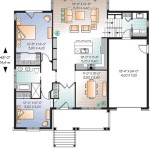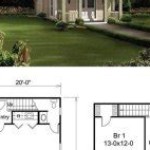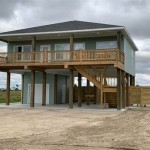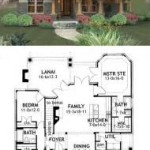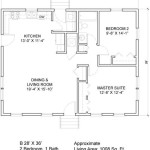Build Your Dream Home With Do-It-Yourself House Plans Free Online
The aspiration of homeownership remains a significant goal for many individuals and families. Building a home, rather than purchasing an existing structure, offers the potential to customize the dwelling to specific needs, preferences, and lifestyle requirements. However, the costs associated with traditional architectural services can be a considerable barrier. Fortunately, the availability of do-it-yourself (DIY) house plans online provides an alternative pathway to realizing this dream, offering a cost-effective and flexible approach to home design. While professional architects offer invaluable expertise, understanding the potential and limitations of free online resources is crucial for informed decision-making.
This article explores the world of DIY house plans available online, focusing on the advantages, disadvantages, and critical considerations involved in using these resources. It aims to provide a comprehensive overview to assist prospective homeowners in evaluating whether this approach aligns with their skills, budget, and the complexities of their intended building project. The objective is to empower individuals with the knowledge necessary to navigate the online landscape of house plans and make informed decisions that lead to a successful and fulfilling home-building experience.
Understanding the Scope of Free Online House Plans
Free online house plans encompass a wide range of resources, varying significantly in quality, completeness, and suitability for different projects. At one end of the spectrum are simple schematic designs intended for basic construction or preliminary inspiration. These may include floor plans, elevation views, and limited structural details. At the other end, some websites offer more comprehensive plans that include detailed construction drawings, material lists, and even 3D renderings.
The source of these plans also varies. Some are contributed by amateur designers or students looking to build a portfolio. Others are offered by established construction companies or material suppliers as a marketing tool to promote their products. Government agencies and non-profit organizations may also provide free house plans to promote affordable housing or sustainable building practices. Regardless of the source, it is crucial to thoroughly evaluate the plans before committing to them.
A key consideration is the level of detail provided. A complete set of construction drawings typically includes not only floor plans and elevations but also foundation plans, framing plans, electrical layouts, plumbing schematics, and mechanical system designs. Furthermore, the plans should specify materials, dimensions, and construction techniques. A lack of detail can lead to ambiguity during construction, potentially resulting in errors, delays, and increased costs.
Another important aspect is the code compliance of the plans. Building codes vary significantly by location and are constantly evolving. Plans that are not compliant with local codes may require extensive modifications, negating the cost savings initially perceived. It is essential to verify that the plans meet the specific requirements of the jurisdiction where the house will be built.
Finally, considering the copyright and usage rights associated with the plans is crucial. While the plans are offered for free, the designer or copyright holder may still retain certain rights. It is important to understand the terms of use and ensure that the plans can be legally used for the intended purpose.
Advantages of Utilizing DIY House Plans
The most significant advantage of using DIY house plans is the potential cost savings. Hiring an architect to design a custom home can be a substantial expense, often representing a significant percentage of the overall project budget. By utilizing free online plans, homeowners can eliminate this cost, freeing up resources for other aspects of the construction process.
Another advantage is the flexibility and control that DIY plans offer. Homeowners can browse various designs and select one that closely matches their needs and preferences. They can also modify existing plans to customize them further, adding or removing rooms, changing the layout, or incorporating specific design features. This level of control allows homeowners to create a home that truly reflects their individual style and lifestyle.
DIY house plans can also be a valuable resource for inspiration and brainstorming. Even if homeowners ultimately decide to hire an architect, browsing online plans can help them clarify their vision and communicate their desires more effectively. By reviewing different designs, they can identify features they like, elements they dislike, and overall styles that resonate with them.
Furthermore, the readily available nature of online plans allows homeowners to begin the planning process quickly and easily. They can access a wide range of designs from the comfort of their own homes, without having to schedule appointments or wait for consultations. This can be particularly beneficial for individuals who are eager to start the building process and want to explore their options immediately.
Finally, utilizing DIY resources fosters a greater understanding of the building process. By actively participating in the design phase, homeowners gain insight into the various elements involved in constructing a home, from structural considerations to material selection. This knowledge can empower them to make more informed decisions throughout the construction process and communicate more effectively with contractors.
Potential Pitfalls and Mitigation Strategies
Despite the advantages, utilizing DIY house plans also presents several potential pitfalls that need careful consideration. One of the most significant risks is the lack of professional expertise. Architects bring years of training and experience to the design process, ensuring that the plans are structurally sound, code-compliant, and aesthetically pleasing. Without this expertise, homeowners may overlook critical design flaws that can lead to costly problems down the road.
To mitigate this risk, it is essential to have the plans reviewed by a qualified building professional before construction begins. A structural engineer can assess the structural integrity of the design and identify any potential weaknesses. A building inspector can verify that the plans comply with local codes and regulations. These reviews will incur additional costs but can save significant money and headaches in the long run.
Another potential pitfall is the complexity involved in modifying existing plans. While the ability to customize plans is an advantage, it also requires a certain level of technical skill and understanding. Altering the structural elements of a plan without proper knowledge can compromise the integrity of the building and create safety hazards. It is advisable to consult with a structural engineer or experienced contractor before making any significant modifications.
The lack of detailed specifications and material lists can also present challenges. Free online plans often provide only basic information about materials and dimensions. Homeowners may need to spend additional time researching and selecting the appropriate materials, which can be time-consuming and overwhelming. To address this, consider supplementing the free plans with detailed material lists from other sources or consulting with a building supply professional.
Furthermore, the absence of professional project management can be a significant hurdle. Architects typically oversee the construction process, ensuring that the project stays on schedule and within budget. Without this oversight, homeowners may need to assume the role of project manager, which requires strong organizational skills, communication abilities, and a thorough understanding of the construction process.
Finally, remember that the "free" aspect of these plans can sometimes be misleading. While the plans themselves may be free, homeowners will still need to pay for printing, modifications, permits, and professional reviews. It is crucial to factor in these additional costs when evaluating the overall affordability of using DIY house plans.

Free Floor Plan Creator Design 2d 3d Layouts Easily

How To Design A House From Sketch Reality

Free Floor Plan Creator Design 2d 3d Layouts Easily

Free Floor Plan Creator Design 2d 3d Layouts Easily

Create And Visualize House Plans In Minutes Roomsketcher

Free Floor Plan Creator Design 2d 3d Layouts Easily

Create And Visualize House Plans In Minutes Roomsketcher

How To Design A House From Sketch Reality

17 Best Free Home And Interior Design Tools

3d Home Design Free Easy House Plan And Landscape Tools Pc Mac
Related Posts

